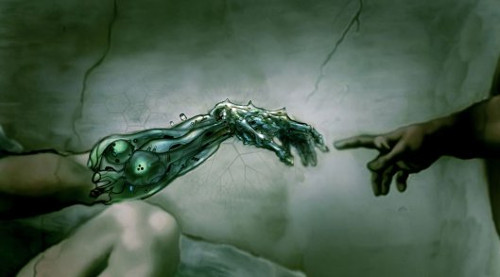Science fiction and posthumanism

For CRITICAL POSTHUMANISM, Sherryl Vint (University of California, Riverside) produced the fascinating essay “SF and posthumanism.”
The genre inspired transhumanism and many SF texts used to be featured on Extropian reading lists; recently, links to genre origins have been erased as such fantasies seem within the grasp of material practice, with descriptions of anticipated technologies that often read like SF. Organizations such as the 2045 Initiative, Extropy Institute,Humanity+, Singularity University, and the Future of Humanity Institute operate in recognizably SF modes. Publications such as Arc Magazine, an offshoot of New Scientist, and the Twelve Tomorrows collections published by MIT Press demonstrate an increased interest in the SF imagination among those developing technology. Recent SF scholarship refers to the genre as a “kind of awareness … that frames and tests experiences as if they were aspects of a work of science fiction.”

Authors who focus on genetic rather than IT technologies include Nancy Kress—who is particularly strong in examining the social consequences of the emergence of the posthuman—Alistair Reynolds, and especially Joan Slonczewski, whose recent Highest Frontier series (2011—) imagines interspecies relations between humans and an alien based on a macroscale version of microbial culture. Much SF also focuses on how material posthuman culture is implicated in the fantasies of a specifically capitalist technoscientific culture, explored most provocatively in the work of Charles Stross and Cory Doctorow.
Beyond obvious connections to technological posthumanism, SF has long imaged subjectivities beyond the human, value systems premised on systems other than humanism, and the expansion of agency and ethics to non-human actors—participating in a long tradition of challenging what Elaine Graham calls the “ontological hygiene” of Western cultures. Here we might read Bruno Latour’s Aramis as a kind of posthuman SF, and there are myriad examples of SF that focuses on animal protagonists whose sentience is either raised by technology or newly recognized by non-anthropocentric culture.

Much of this SF, especially the transcendental fantasies of human-machine fusion, remain largely humanist in their frames—imagining an augmented version of the autonomous liberal subject. Equally as much, however, achieves the transformational capacity Cary Wolfe calls “posthumanist posthumanism,” reconceiving not only its subject as posthuman but also transforming the very categories by which subjectivity is comprehensible. Stanislaw Lem’s Solaris (1961), Ian Wilson’s The Jonah Kit (1975), and Joseph McElroy’s Plus (1977) exemplify different facets of this aptitude. The genre’s chief power is its recognition that the human is only one among countless species, our history only a fragment of the story of the universe.
Check out the rest of Vint’s intriguing essay at CRITICAL POSTHUMANISM.
For more about SLOW BULLETS, visit the Tachyon page.
Cover art by Thomas Canty.
Design by Elizabeth Story.
For information on YESTERDAY’S KIN, visit the Tachyon page.
Cover by Thomas Canty.
